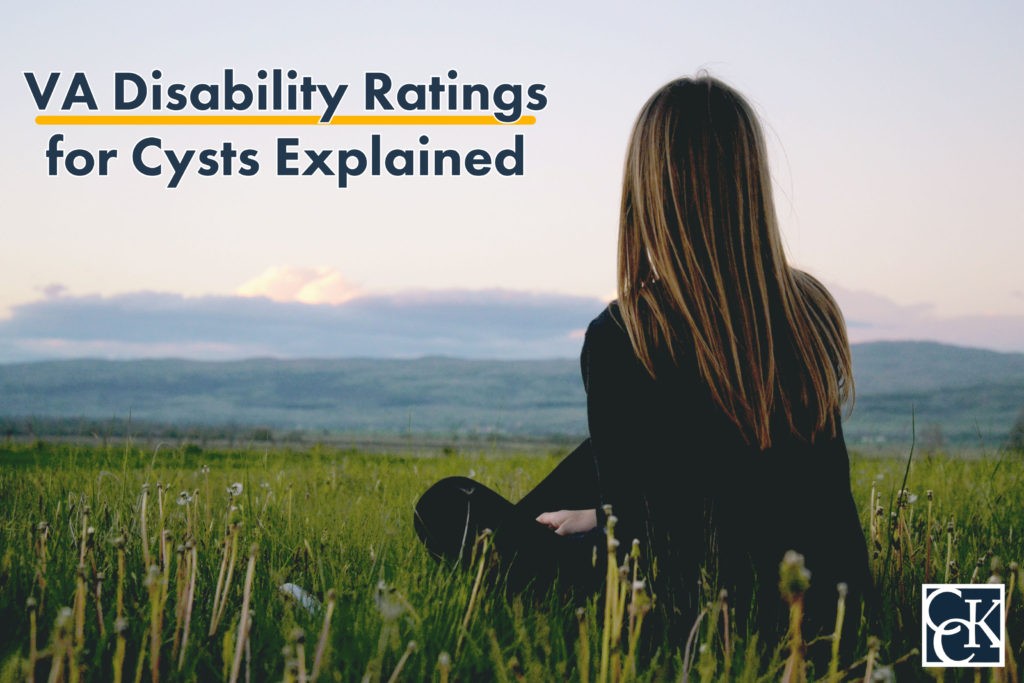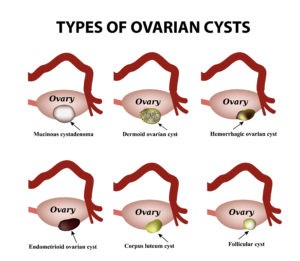VA Disability Ratings for Cysts Explained

CCK Law: Our Vital Role in Veterans Law
The number of veterans suffering from cysts has risen sharply in the past decade, with some forms of cyst nearly doubling in incidence rates among veterans, according to one 2023 study. Painful, impeding, and sometimes dangerous, cysts are recognized by the Department of Veterans Affairs (VA) as a compensable condition if they are related to a veteran’s military service.
If you are a veteran suffering from cysts, this article will help guide you through the VA claims process for your condition so you can potentially earn disability compensation.
Key points of this article include:
- Cysts come in a variety of forms and sizes. While some forms of cyst are relatively harmless, others can lead to or indicate serious health problems, including cancer.
- In order to earn a disability rating for cysts, veterans first have to establish service connection to VA, linking the development of their cysts to their former military service.
- Once service connection is established, VA can award veterans with a 0, 10, or 30 percent disability rating for their cysts, depending on symptom severity and other factors.
What Are Cysts?
Cysts are abnormal sacs or bulges, often containing fluid, that can form in the skin or in the body. Although there are many different types, most are not cancerous. Most frequently, cysts can be found in the skin, ovaries, breasts, and kidneys.
What Types of Cysts Can Affect Veterans?
There are multiple kinds of cyst that can develop in veterans, including:
- Ganglion cysts – Ganglion cysts occur within the tendons or joints of the wrists, hands, ankles, or feet. This type of cyst can be painful when it presses on nearby nerves, and can even interfere with joint movement. Ganglion cysts are most common in women, specifically between the ages of 20 and 40. At increased risk are people who experience osteoarthritis or joint and tendon injuries.
- Pilonidal cysts – Pilonidal cysts occur in the buttocks, usually near the tailbone at the top of the left buttocks. They often contain hair or skin cells, but can also be filled with pus or blood and may produce a foul smell when drained. Symptoms also include pain and reddening of the skin. It is important to seek proper medical treatment for this kind of cyst, since neglecting treatment may lead to an increased risk of squamous cell carcinoma, a form of skin cancer.
- Ovarian cysts – Ovarian cysts are fluid-filled sacs or pockets that grow on a woman’s ovaries. While common and fairly harmless, larger ovarian cysts can cause bloating, pelvic pain, or a feeling of heaviness in the abdomen. Additionally, ovarian cysts that rupture can lead to very serious issues, including severe abdominal pain coupled with a fever or vomiting. These are signs that a veteran should seek medical attention immediately. There are multiple kinds of ovarian cyst, including follicular, corpus luteum, dermoid, cystadenoma, and endometrioma, each with varying degrees of severity.

How Do I Prove Service Connection for Cysts?
In order to establish direct service connection for cysts, the veteran will need to show that their cysts were somehow caused by their military service. To do so, veterans will have to provide evidence of three key elements:
- A diagnosis of cysts noted in the veteran’s medical record.
- A description of how the veteran’s service contributed to or caused the cysts. Specifically for ovarian, the veteran should establish how the service contributed to or caused gynecological issues.
- A medical nexus linking the current, diagnosed cysts to service.
Secondary Service Connection for Cysts
Veterans who develop conditions as a result of their cysts can also file for secondary service connection. An example of a secondary condition stemming from ovarian cysts might be if it ruptured, causing internal bleeding or sepsis. The veteran may then be entitled to compensation because the secondary condition was then caused by the primary condition. In order to be compensated for the secondary condition, the veteran would need to:
- Already be service-connected for cysts;
- Provide a diagnosis for the secondary condition;
- Provide medical evidence, or a nexus, showing the relationship between the cyst(s) and the secondary condition.

How Does VA Assign Disability Ratings for Cysts?
VA rates cysts under several different diagnostic codes depending on the specifics of the veteran’s condition and whether treatment is required. For ovarian cysts, VA uses diagnostic code 7615 under 38 C.F.R. § 4.116 – Gynecological Conditions or Disorders of the Breast. These criteria are as follows:
- 0 percent – Symptoms that do not require continuous treatment
- 10 percent – Symptoms that require continuous treatment
- 30 percent – Symptoms not controlled by continuous treatment
With ovarian cysts, a veteran’s ovaries may become non-functional or may require the veteran to undergo a hysterectomy. A hysterectomy is the removal of the uterus, where one or both of the ovaries could be removed. If complications from an ovarian cyst require the removal of one or both ovaries, then the veteran may be eligible for special monthly compensation based on functional loss of an organ or body part.
Alternatively, cysts on other parts of the body may be rated analogously under 38 C.F.R. § 4.118 – Schedule of Ratings for the Skin. Under this schedule of ratings, a few different diagnostic codes (DC) could be used to evaluate a veteran’s cysts, including DC 7800 (for disfigurement of the face or neck), DC 7801-7805 (for general scarring), or DC 7818 and 7819 (for skin neoplasms).
What Does a Compensation and Pension (C&P) Exam for Cysts Look Like?
Compensation and Pension (C&P) exams for cysts may take a few different forms, depending on the kind of cyst a veteran suffers from. Ovarian cysts, for instance, will likely require that the examiner perform a gynecological exam on the veteran, while cysts on the skin can likely be examined with minimal invasiveness. An example C&P exam may resemble the following:
- First off, VA will usually send the veteran a letter requesting a C&P examination. It is very important that the veteran follows up with scheduling the exam, as VA can deny a veteran’s claim if they do not attend the examination.
- Prior to the exam, the examiner will typically review the veteran’s claims file. The claims file contains medical treatment records and evidence that has been submitted to VA previously. The claims file typically also includes the veteran’s service records.
- During the exam, the VA medical practitioner will likely perform some kind of physical. This might involve a gynecological exam for ovarian cysts, or a less invasive skin exam for other forms of cyst.
- In addition to the physical exam, the examiner may also ask questions regarding the cyst, any claimed secondary conditions, or their relation to service. Usually, these questions come from the Disability Benefits Questionnaire. The questions on the Disability Benefits Questionnaire (DBQ) are intended to give the veteran an opportunity to speak on their condition, symptoms, severity, and relation to other conditions.
- After the C&P exam, the examiner will issue an opinion. The opinion will either be favorable or unfavorable. A favorable opinion will support the notion that the veteran’s cysts are related to service, while an unfavorable opinion will not support service connection.
C&P exams are important because they allow VA to collect more information regarding a veteran’s claimed condition. If VA rules in favor of service connection for the veteran’s claimed condition, the exam may additionally be used to determine what rating the veteran receives. The rating will then correspond to how much compensation the veteran will receive.
Notably, if the veteran receives a negative opinion, they can obtain a second opinion to refute the VA examiner’s opinion. A medical expert can provide a second opinion.

About the Author
Share this Post
